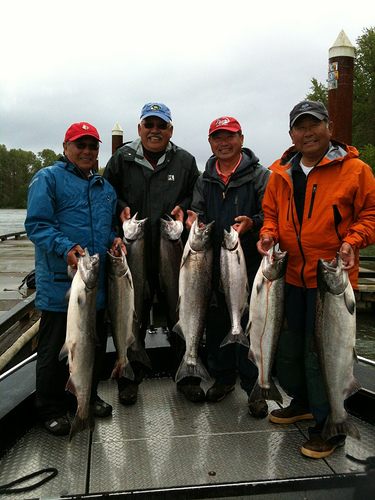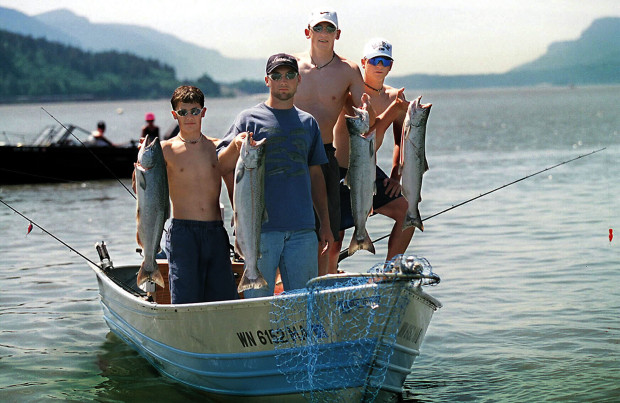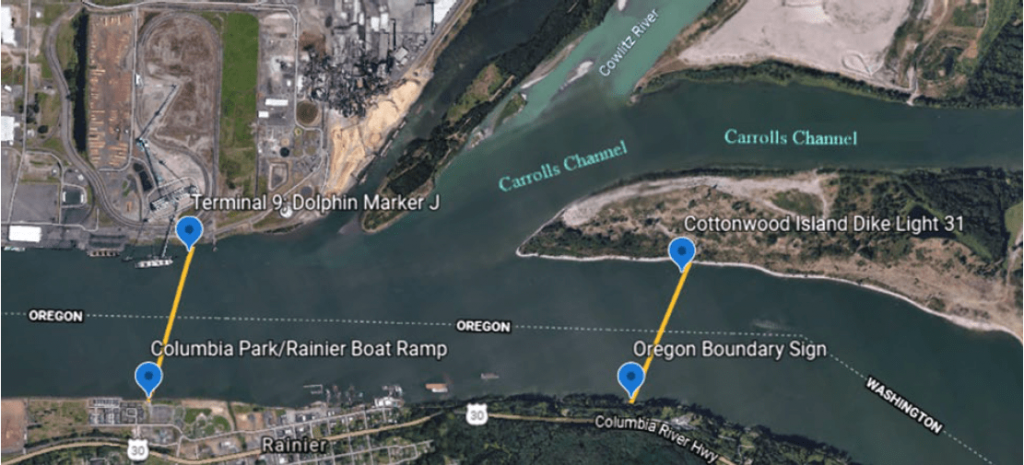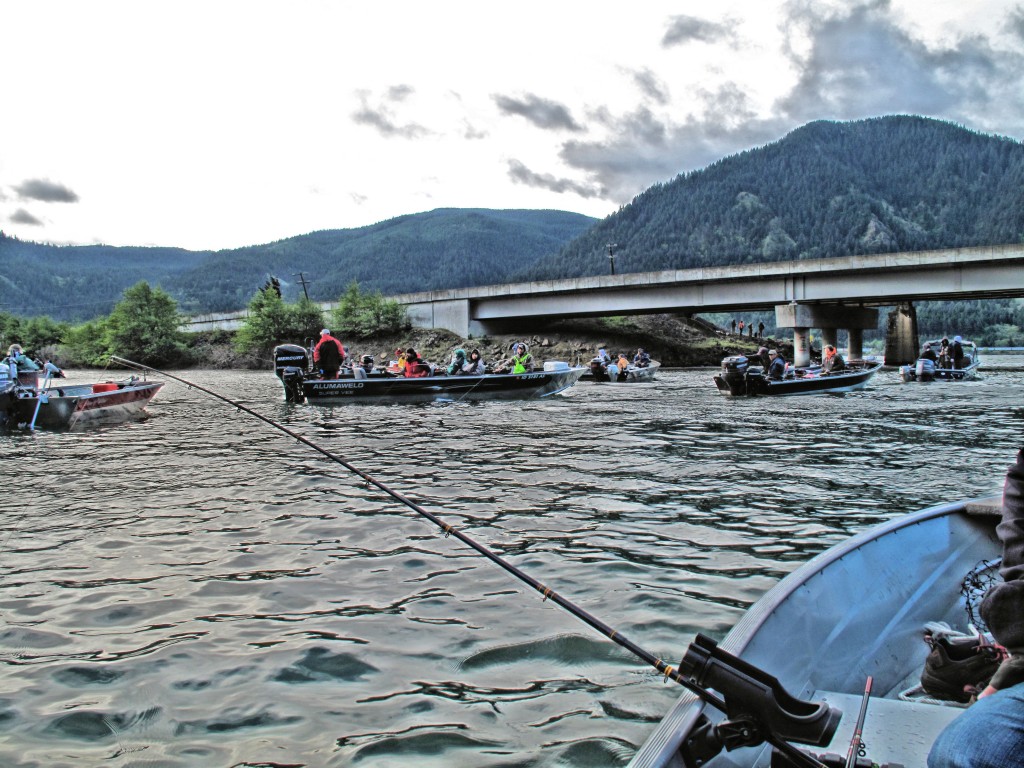UPDATED: Columbia River spring chinook fishing dates set by state fishery managers today, and includes a 35-day lower mainstem season beginning this Monday Leave a reply

By Mark Yuasa
Spring is less than a month away and anglers received official word during a joint state, federal and tribal fishery managers meeting today on Columbia River spring chinook fisheries that are set to begin this coming Monday (March 1).
The forecast calls for 143,200 spring chinook – compared to 135,800 forecast in 2020 and an actual return of 142,494 – with 68,000 headed to lower river tributaries, most (50,000) are bound for Willamette and another 75,200 comprised of upriver stocks.
Spring chinook – the first migrating salmon to arrive in Washington – are prized for their tasty, Omega-3-laced, red-orange-colored meat, which is similar to fish from Alaska’s Copper River.
Under permanent regulations, the 2021 spring chinook fishery on the Lower Columbia has been open daily since Jan. 1 through March 31 from Buoy 10 to the I-5 Bridge.
Fishery managers approved a hatchery-marked spring chinook 35-day fishing season from March 1 through April 4 on Lower Columbia mainstem from Buoy 10 line upstream to Beacon Rock (boat and bank) plus bank angling only from Beacon Rock upstream to the Bonneville Dam deadline. The daily limit is two adult hatchery chinook or steelhead, but only one may be a chinook. Shad may also be retained. All other permanent regulations apply.
The regulation also states that only hand-cast lines may be used from Beacon Rock to the Bonneville Dam deadline that prevents bank anglers from using kayaks or boats to place their lines in deeper water than they can cast to.
This is the first time in the past three years the lower river downstream of St. Helens and Woodland will be open since three hatcheries are expected to achieve spring chinook spawning goals.
The Columbia mainstem above Bonneville Dam Oregon/Washington border will have a 51-day hatchery spring chinook fishing season from March 16 through May 5. The daily limit is two adult hatchery chinook or steelhead, but only one may be a chinook. Shad may also be retained. All other permanent regulations apply

There is a spring chinook abundance-based sliding scale harvest rate schedule for upriver spring chinook. Based on the buffered 2021 preseason forecasted abundance, the harvest-rate schedule allows for an ESA impact rate of 1.0 percent for non-treaty fisheries occurring prior to the run update.
Spring chinook returns have been quite bit lower than the average in the past five years. There was a couple of run sizes that were around 115,000 and runs are down historically and have been trending as late arriving as far as fish passage over Bonneville Dam. Some of the latest arriving runs on record occurred in 2017, 2018 and 2020.
Catch expectations are approximately 3,025 adult spring chinook will be kept (2,159 upriver mortalities) for the Lower Columbia sport fishery downstream of Bonneville Dam (98 percent of the pre-update guideline for this fishery) and 292 adult chinook kept (300 mortalities, all upriver stock) for the fishery upstream of Bonneville Dam (95 percent of the pre-update guideline for this fishery).
On the call this morning, state fishery managers were hopeful a return to more normal spring chinook run sizes to reflect the 10-year average over the last five years will occur in near future.
The first spring hatchery chinook of 2021 was caught on Feb. 1 in the Lower Willamette River and weighed just under 17 pounds. It isn’t unusual each winter to see the first fish caught in January or early February either in the Lower Columbia, Multnomah Channel or Lower Willamette.
The height of the return is March and April, when anglers breaking out of the winter doldrums creating an early fishing frenzy along the Columbia.
In order to allow enough spring chinook to return to the Cowlitz and Lewis rivers, fishery managers are proposing a one-mile no-boat-angling bubble closure near the Cowlitz mouth and Carrolls Channel to provide additional conservation for this stock.

This WDFW map shows the boundary lines of the proposed no-boat-angling bubble zone at the Cowlitz River mouth and Carrolls Channel. Map provided by WDFW.
Just like in 2019 and 2020, the Cowlitz River is expected to be closed for spring chinook retention. Spring chinook returns are better in 2021 for the Kalama and Lewis rivers and it doesn’t appear a closure below Warrior Rock is on the table. All Lower Columbia Washington tributary regulations are currently open for fishing and modifications will be made through emergency rules.
“Generally speaking, the lower river tributaries are a mixed bag with some higher and some lower,” Ryan Lothrop, a WDFW salmon manager said.
“The Kalama is better (a forecast similar to recent five-year average return of 2,400) and we should be able to provide a fishery,” Lothrop said. “The Lewis is higher than last year (20 percent higher than recent five-year average return of 1,800) and there is reason to believe that we’ll have some fishing opportunity. The Cowlitz is your question mark since it does push us into that window around the escapement goal.”
The preliminary 2021 forecast for the Cowlitz is 1,777 (1,400 was forecast and 908 was actual return in 2020); Kalama is 2,133 (1,000 and 1,215); and Lewis is 2,283 (1,400 and 1,874). On Oregon side, the Sandy is 5,300 (5,200 and 7,618).

The Lower Columbia mainstem spring chinook fishery produced 36,250 angler trips in 2020 (the lowest since 2000) with 1,462 adult hatchery spring chinook kept and 1,218 released and 1,129 hatchery steelhead kept and 399 released. The spring season was open daily from Jan. 1-Feb. 28 from Buoy 10 to I-5 Bridge, and May 5, 7, 9, 13, 15-17 and 20 from Warrior Rock to Bonneville. The sockeye fishery opened on May 15 and 1,119 sockeye were kept and 105 released.
In 2019 and 2020 an initial emergency closure was issued on March 1 below Warrior Rock on the Lower Columbia mainstem to protect spring chinook destined for Cowlitz and Lewis. Those were followed by closures in late-March through April due to COVID-19.
Spring chinook returns to tributaries above Bonneville Dam are showing some signs of improvement in 2021 although most are recovering from bad ocean conditions between 2015 and 2019 that were among the worst in the past 20 years.
The 2021 Wind forecast is 1,200 (2,000 was forecast and 2,076 was actual return in 2020, and 2,800 and 1,600 in 2019); Drano Lake aka Little White Salmon is 3,900 (4,600 and 3,841, and 5,600 and 3,600); and Klickitat is 1,500 (1,800 and 1,517, and 1,100 and 400).
The Columbia above Bonneville to McNary for spring chinook had a brief eight-day season (May 5, 7, 9, 13, 15-17 and 20) that saw 5,652 angler trips with 519 adult spring chinook kept and 159 released. The section at McNary to Oregon-Washington boundary yielded just 10 adult spring chinook kept and three released during the same time frame.
Two sections of the Snake River spring chinook season were open two days per week from May 5-22, and generated 6,757 angler hours with 326 adult spring chinook kept and 59 released.

